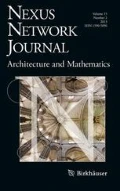Abstract
Precisely capturing context is a fundamental first step in dealing with built environments. Previous research has demonstrated that existing methods for generating as-is floor plans of non-orthogonal rooms by non-expert users do not produce geometrically accurate results. The present paper proposes the adaptation of empirical triangulation methods, traditionally used by architects and other building professionals in surveying building interiors, to the development of semi-automated workflow of room survey. A set of triangulation algorithms that automate the plan drawing stage are presented.










Similar content being viewed by others
References
Ameijde, Jeroen van. 2019. The Architecture Machine Revisited: Experiments exploring Computational Design-and- Build Strategies based on Participation. SPOOL 6. S.I.: 17–34. https://doi.org/10.7480/spool.2019.1.3890.
Becker, Ralf, Elisa Lublasser, Jan Martens, Raymond Wollenberg, Haowei Zhang, Sigrid Brell-Cokcan, and Jörg Blankenbach. 2019. Enabling BIM for Property Management of Existing Buildings Based on Automated As-is Capturing. In: Proceedings of the 36th International Symposium on Automation and Robotics in Construction, Banff. https://doi.org/10.22260/ISARC2019/0028.
Brandão, Filipe J. S., and Alexandra Paio. 2019. CONTEXT-AWARE MASS CUSTOMIZATION CONSTRUCTION SYSTEM: Methods for user captured as-built plans. In Intelligent & Informed - Proceedings of the 24th CAADRIA Conference, 2:101–110. Wellington, New Zealand: Victoria University of Wellington.
Brilakis, Ioannis, Manolis Lourakis, Rafael Sacks, Silvio Savarese, Symeon Christodoulou, Jochen Teizer, and Atefe Makhmalbaf. 2010. Toward automated generation of parametric BIMs based on hybrid video and laser scanning data. Advanced Engineering Informatics 24: 456–465. https://doi.org/10.1016/j.aei.2010.06.006.
Brown, John L. 2016. Going Home: Future Adaptive Building for Aging-in-Place. PhD thesis, Melbourne, RMIT University.
Carpo, Mario. 2011. The Alphabet and the Algorithm. Cambridge: MIT Press.
Chazelle, Bernard. 1990. Triangulating a simple polygon in linear time. In Proceedings [1990] 31st Annual Symposium on Foundations of Computer Science, 220–230. St. Louis, MO, USA: IEEE Comput. Soc. Press. https://doi.org/10.1109/FSCS.1990.89541.
Chazelle, Bernard. 1982. A theorem on polygon cutting with applications. In 23rd Annual Symposium on Foundations of Computer Science (sfcs 1982), 339–349. Chicago, IL, USA: IEEE. https://doi.org/10.1109/SFCS.1982.58.
Chazelle, Bernard, and Janet Incerpi. 1983. Triangulating a polygon by divide-and-conquer. Proceedings - Annual Allerton Conference on Communication, Control, and Computing, eds. H Vincent Poor, Donna J. Brown; Tamer Başar, 447–456. Urbana-Champaign: University of Illinois.
Chevrier, Christine, Nathalie Charbonneau, Pierre Grussenmeyer, and Jean-Pierre Perrin. 2010. Parametric Documenting of Built Heritage: 3D Virtual Reconstruction of Architectural Details. International Journal of Architectural Computing 8: 135–150. https://doi.org/10.1260/1478-0771.8.2.135.
De Berg, Mark, Otfried Cheong, Marc van Kreveld, Mark Overmars. 2008. Computational Geometry: Algorithms and Applications, 3rd ed. Berlin: Springer.
de Rezende, Pedro J., Cid C. de Souza, Stephan Friedrichs, Michael Hemmer, Alexander Kröller, and Davi C. Tozoni. 2014. Engineering Art Galleries. arXiv:1410.8720 [cs.CG].
Duarte, José Pinto. 2005. A discursive grammar for customizing mass housing: The case of Siza’s houses at Malagueira. Automation in Construction 14: 265–275. https://doi.org/10.1016/j.autcon.2004.07.013.
ElGindy, Hossam, Hazel Everett, and Godfried Toussaint. 1993. Slicing an ear using prune-and-search. Pattern Recognition Letters 14: 719–722. https://doi.org/10.1016/0167-8655(93)90141-Y.
Friedman, Yona. 1971. The Flatwriter: Choice by Computer. Progressive Architecture, March 1971: 98-101.
Garey, Michael R., David S. Johnson, Franco P. Preparata, and Robert E. Tarjan. 1978. Triangulating a simple polygon. Information Processing Letters 7: 175–179. https://doi.org/10.1016/0020-0190(78)90062-5.
Giordano, Andrea, Paolo Borin, and Federico Panarotto. 2019. Digital Wood Trusses. Geometry and Parameters/Fabrication and Monitoring. In Digital Wood Design, eds. Fabio Bianconi and Marco Filippucci, 24:479–509. Cham: Springer International Publishing. https://doi.org/10.1007/978-3-030-03676-8_18.
Jung, Jaehoon, Sungchul Hong, Seongsu Jeong, Sangmin Kim, Hyoungsig Cho, Seunghwan Hong, and Joon Heo. 2014. Productive modeling for development of as-built BIM of existing indoor structures. Automation in Construction 42: 68–77. https://doi.org/10.1016/j.autcon.2014.02.021.
Khalili-Araghi, Salman, and Branko Kolarevic. 2020. Variability and validity: Flexibility of a dimensional customization system. Automation in Construction 109: 102970. https://doi.org/10.1016/j.autcon.2019.102970.
Kolarevic, Branko, and José Pinto Duarte, ed. 2019. Mass Customization and Design Democratization. New York: Routledge.
Marble, Scott, ed. 2012. Digital Workflows in Architecture: Design, Assembly, Industry. Basel: Birkhäuser.
Murphy, Maurice, Eugene McGovern, and Sara Pavia. 2013. Historic Building Information Modelling – Adding intelligence to laser and image based surveys of European classical architecture. ISPRS Journal of Photogrammetry and Remote Sensing 76: 89–102. https://doi.org/10.1016/j.isprsjprs.2012.11.006.
Pătrăucean, Viorica, Iro Armeni, Mohammad Nahangi, Jamie Yeung, Ioannis Brilakis, and Carl Haas. 2015. State of research in automatic as-built modelling. Advanced Engineering Informatics 29: 162–171. https://doi.org/10.1016/j.aei.2015.01.001.
Steadman, Philip. 2006. Why are most buildings rectangular? arq: Architectural Research Quarterly 10: 119. https://doi.org/10.1017/S1359135506000200.
Tzedaki, Vasiliki, and John M. Kamara. 2013. Capturing As-Built Information for a BIM Environment Using 3D Laser Scanner: A Process Model. In AEI 2013, 486–495. State College, Pennsylvania, United States: American Society of Civil Engineers. https://doi.org/10.1061/9780784412909.047.
Weinzapfel, Guy, and Nicholas Negroponte. 1976. Architecture-by-yourself: an experiment with computer graphics for house design. In SIGGRAPH ‘76: Proceedings of the 3rd annual conference on Computer graphics and interactive techniques, 74–78. ACM Press. https://doi.org/10.1145/563274.563290.
Xiao, Jianxiong, and Yasutaka Furukawa. 2012. Reconstructing the World’s Museums. International Journal of Computer Vision 10(3). https://doi.org/10.1007/s11263-014-0711-y.
Acknowledgments
This work was supported by a merit scholarship granted by ISTA—Escola de Tecnologias e Arquitetura of ISCTE—Instituto Universitário de Lisboa for the development of the first author’s PhD thesis and by Fundação para a Ciência e a Tecnologia (FCT) projects UIDB/04466/2020 and UIDP/04466/2020. The authors would also like to express their gratitude to Editor Kim Williams for her meticulous editing and suggestions. All images are by the author.
Author information
Authors and Affiliations
Corresponding author
Additional information
Publisher's Note
Springer Nature remains neutral with regard to jurisdictional claims in published maps and institutional affiliations.
About this article
Cite this article
da Silva Brandão, F.J., Paio, A. & Lopes, A. Triangulation Algorithms for Generating As-Is Floor Plans. Nexus Netw J 22, 683–700 (2020). https://doi.org/10.1007/s00004-020-00491-3
Published:
Issue Date:
DOI: https://doi.org/10.1007/s00004-020-00491-3




